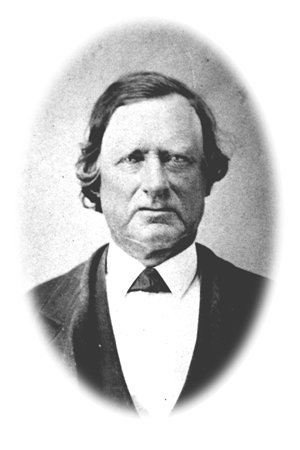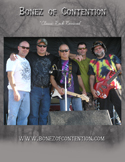Phelan Story
This is the story of the Phelan family history as submitted to me by Raymond John Phelan, the Great, Great, Great, Grandson of John Phelan Sr.
Below is a picture of John Jr. the founder of Chepstow, Ontario.

John Phelan Jr.
1815-1888
An Irish Story
By - Raymond John Peter Phelan
I have always been intrigued by the story of my Irish ancestors. For years I have delved into the documents and histories that detailed their struggles and adventures. The recent attention given to Frank McCourt's Angela's Ashes made me determine to put down on paper what I have discovered. The years spent researching also roughly paralleled the years in which I left and then returned to the Catholic Faith. I am grateful to many for helping me along that road, but I am especially thankful for the faith of my fathers, John, James, Dennis, Patrick and the others whose stories I now recount.
On August 22, 1808, my Great Great Great Grandparents, John Phelan and Susana Whittaker were married by special permission at Saint Mary's Catholic Church in Kilkenny, Ireland. They needed special permission because Susana was a Protestant from Northern Ireland and John a Roman Catholic from Ballyragget. At the time of their marriage the Penal Laws were enforced in all of Ireland. The Penal Laws, dating from 1695, barred Catholics from the army and navy, the law, commerce and from every civic activity. No Catholic could vote. Catholic land ownership was broken by an enactment directing that at the death of a Catholic owner his land be divided among all his sons, unless the eldest became a Protestant. Then he would inherit all the land. Roman Catholics were forbidden to receive an education, he could not establish a school or send his children to be educated abroad. The practice of the Catholic faith was restricted, informing was encouraged and priest hunting was treated as a sport. A Roman Catholic was forbidden to own a horse of greater value than five pounds and he could not buy or lease land. On John and Susana's wedding day, Roman Catholics owned less than seven percent of Irish soil.
John and Susana made their home on the outskirts of Ballyragget near others in John's family. On Sunday's they would walk the Mass Path to the church in Ballyragget. The Mass Paths were the freeways of Ireland in the 1800's. People used them to travel to church, shop, or visit friends. The walk to and from Mass was the social highlight of the week. Friends like the Downeys, McEvoys, Tynans, Costelloes, Campions, Shearmans, Hallys Delaneys and Phelans would take their time along the way to share the latest news and swap stories. The paths gradually declined thanks in part to the automobile, which brought improved roads. By the early 1960's few people ventured onto the "slippery when wet" trails.
John and Susan and their eight children lived in Ballyragget until they emigrated to North America in 1831. I believe there were two events that influenced them in their decision to emigrate. The first was Catholic Emancipation. The Emancipation process began in 1821 when the English House of Commons passed the Catholic Relief Bill. The bill proposed to make Catholics eligible for Parliament but it included an unacceptable condition. The Roman Catholic clergy had to take an oath to elect only bishops who were loyal to the Crown. The bill was vetoed. It wasn't until 1826 that the Emancipation Bill was passed. All of the Penal Laws were lifted and the Irish Catholics no longer were excluded from participating in civil law and commerce. However, practically speaking, Irish Catholics continued to toil under the effect of the old laws.
The second event, that influenced them, was the creation of the Canada Company in London and its purchase of 1,100,000 acres of land from the Chippewa Indians. The land, located in the lee of Lake Huron in the province of Ontario, was very good land. The development of the land began in 1827 under the supervision of the company's man in Canada, John Galt. John Galt envisioned building "an asylum for the exiles of society" in the Huron wilderness. At the same time, the company recognized the potential for a significant return on their investment. Land was purchased by the company at 75 cents an acre and sold for $1.50 to $2.50.
John Phelan made arrangements to purchase several hundred acres in the Huron Tract. In the Spring of 1829, he and his sons James and Michael, along with his son-in-law Patrick Downey, sailed on a Canada Company ship to Montreal, Quebec. Upon arriving in Canada they headed west for what was then known as Upper Canada. They cleared "their land" and built new homes for Michael, James and Patrick. In 1832, James remained in Canada to watch over their holdings while the rest returned to Ballyragget to gather together the Phelans and bring them to their new home - Stratford, Ontario.
Stratford had a total population of 39 pioneers in 1833. Early in June of 1833, Stratford had its first Catholic Baptism and marriage. Father Dempesy made the trip through the bush from Saint Thomas to celebrate the sacraments and say Mass. Father Dempsey stayed at the home of John and Susana whenever he was in the area. In 1837, the Phelans joined their Catholic brothers and sisters and built the first Roman Catholic Church in Stratford named after Saint Joseph.
The Phelans managed to put together enough money to purchase lumber milling equipment. They quickly established a prosperous enterprise supplying hewn lumber for the diverse group of pioneers venturing into the wilderness from the British Isles and Europe. The Germans, Scottish, English and Irish promptly named streets after their patron saint - St. Michael St. Andrew, St. George and St. Patrick. Unfortunately, the religious and political prejudices of their homelands were brought with them to Stratford and the history of Canada is filled with stories of strife between those who were loyal to the Crown of England and those who longed to be free of British domination. The Phelan's were part of the latter.
On January 6, 1845, the conflict erupted in earnest at a regular town meeting. The meeting had been called to elect new district councilors. W. F. McCulloch and James Simpson were elected to act as new councilors. Simpson was a Scotsman who supported the Orange Lodge and McCulloch was an English Catholic. The Irish Catholics of Stratford were now outnumbered about three to one on the council. The Irishmen spent the afternoon drinking and nursing their grievances. When the town meeting broke up, the Irishmen watched Simpson and McCulloch go into the traditional meeting place, the Shakespeare Hotel. The Irishmen followed. The new councilors were celebrating when the Irishmen forced their way into the hotel. However, the celebrants had anticipated an attack and were armed with bayonets and axe handles. The Shakespeare Hotel was nearly destroyed before the fighting moved out into the street. No one was killed, thanks to 30 special constables that the Justice of the Peace had hired as a precaution. There were severe injuries and bloody heads and 27 men were arrested.
They sent a special agent to keep the peace before the next meeting in January 1846. Councilman McCulloch asked for help from the neighboring town of Goderich. They sent a special agent to keep the peace. He arrived to find that an arsenal of guns, knives, scythes and axe handles were placed within reach. The meeting ended peacefully, but the bitter feelings were still present.
On the evening of August 26, 1847, John Phelan Sr. was to attend a public meeting held in the village. When he did not return home, his son, John Phelan Jr., set out looking for him. John found his father lying in the middle of the road. His father was breathing and moaning but not unable to speak. He enlisted the help of a neighbor and carried his father into the house of William Terry where his father spent the night. The next morning when John Jr. returned to Mr. Terry's, he found his father in the same condition as the night before. Doctor Moore was sent for and attended to the old man until his death at 10:00 AM on the morning of the 27th. Dr. Moore found several bruises on his side and about his head, as if he had been beaten. John's father was never able to tell them how he received the bruises or what happened to him. The condition of his body and the discovery of the bruises persuaded John to request that the coroner, Robert Blair Linton, conduct an inquest and investigate the cause of his father's death. Several villagers testified that early in the afternoon of August 26th, they observed John Duffy, a Stage Driver, push John Phelan Sr. to the ground and take a coat from him. Mr. Duffy kicked John several times while he lay helpless on the ground. John made several attempts to get to his feet but was unable. Mr. Duffy left him lying in the road.
Several other villagers testified that they observed Mr. Phelan walking through the village in what appeared to be a drunken stupor. On several occasions throughout the day, John arrived at Brown's Tavern requesting a drink. Mr. Brown thought that John was a little, only a little, worse for the drink and didn't serve him. After hearing all the testimony Dr. Moore was asked to perform an autopsy on John Phelan. The autopsy included an examination of his brain. The condition of his brain and the testimony the witnesses gave regarding his stumbling and slurred speech led the Doctor to conclude that John died of a stroke, not from the bruises found on his body. This conclusion didn't rest well with the Phelan family. They were all quite sure there was a more sinister explanation for the death. Within five years, all eight children and their families would leave the community they helped to establish.
A paragraph taken from the History of Greenock Township reads: "In 1852, John Phelan Jr., his wife Bridget, daughter Mary and his older brother Dennis left Stratford for Riversdale. There they hired a man named McDonald to take them down the Yokassippi River in a large canoe hollowed out of a pine log. Leaving civilization behind, they penetrated the wilderness. In the evening of the first day, May 17, they found a spot along the riverbank and spent the night under a huge hemlock tree. In the morning, they discovered a rude bark shanty that surveyors had used. This became their home until their log house was built."
John and Dennis moved their milling equipment from Stratford to the new site. Ample need for a sawmill was apparent for the Phelans were not alone on the river for very long. Some of the settlers that followed them were the Coumans, Tooheys, Campbells, McKinnons, Stapletons, Kellys, Donnellys and Flemings. John and Dennis built a dam on the river to power their mill. The work of clearing the land, building homes and barns began in earnest. The location was excellent as a natural valley extended upstream. The soil was fertile for planting and raising livestock and the little community soon became known as Phelan's Dam.
After several years of prosperity, John felt it was time to give the little village a proper name. He consulted with his neighbors, most of whom were Irish, and petitioned the government for a Post Office, which was to bear the name of Emmett. Robert Emmett was an Irish patriot who was hanged for rebellion in 1803 and John wanted to honor him in this small way. This was not to be. Someone in the Postal Department changed the name to Chepstow, which was the residence of Earl Strongbow, the first invader of Ireland in 1170. John immediately recognized the implication of the change and it is said that my GG Grandfather never forgave the Government.
Government and Religion played a major role in John and Dennis' life. The log house they built on the river became the first church. Missionary priests would make the trip from Hamilton to say Mass in their home. Father Matoga, a Jesuit Missionary, was the first to do so. His visits to the Phelan's settlement were infrequent as missionaries were few and travel on foot through the dense forest was difficult. On these occasions, John's wife Bridget prepared a grand meal in a sugar kettle for the priest and settlers who walked through the bush to attend Mass in the Phelan's home.
After Father Matoga's death, Fathers William Blattner and George Laufhuber served the parish until 1860. Father Macog also visited the Phelan's settlement accompanied by a Chippewa Indian boy who served as an altar boy. In 1863, a frame church was built and dedicated by Bishop Farrell in 1865 to Saint John the Baptist. The name was chosen to honor two pioneers, John Coumans and John Phelan. The parish outgrew the frame church and in 1903 John's nephew, Tomas Mullin constructed a brick church dedicated to Mary Immaculate. The church still stands today with a beautiful stained glass window dedicated in memory of John and Bridget Phelan.
John and Bridget Phelan had ten children. Two of their daughters, Bridget and Mary, entered religious life. Mary entered the Sisters of Mercy in Buffalo, New York and Bridget the Sisters of Loretta, Toronto, Ontario. Their sons, Michael, Patrick, John and James (my Great Grandfather) moved to Gagetown, Michigan. Their father bought them 400 acres of fertile soil for potato farming. James raised his eleven Children there on his farm.
James and Sarah Phelan's youngest daughter Mildred responded to God's call and entered the convent of the Dominican Sisters in Adrian, Michigan. Sister Marie Emmanuel was a diabetic but she didn't let that slow her down. In 1964, she visited the Soviet Union as the first person of a religious order to visit Russia after the start of the Cold War. Sister was only 4' 11" and her traveling companion, Sister Ann Joachim, was much taller. Their striking appearance, dressed in the habit of the Dominican order, attracted much attention when they stood as tourists in Red Square. When they left the USSR they proceeded to Rome where they had an audience with Pope Paul VI. When I pray the Rosary I use the Rosary that His Holiness blessed and gave my Great Aunt.
Another descendant of James, his Great Grandson, is Bishop John Nienstedt. Bishop Nienstedt is an Auxiliary Bishop in the Diocese of Detroit. Remember Dennis? Well Dennis and Mary Phelan had nine children. Their son Patrick left Chepstow and settled a small farm in Holyrood, Ontario. Patrick quickly became bored and decided that he needed more adventure in his life. In 1872, Patrick left Holyrood and headed for Kansas on horseback. He participated in one Texas cattle drive in the same year and discovered cattle driving wasn't exactly what he was looking for. He returned to Kansas and made his home in a dugout on Plum Creek. The Coorigans joined Patrick and later his mother and father. Patrick and Dennis petitioned the postmaster to name their new settlement Holyrood, after Patrick's home in Holyrood, Ontario, and their request was granted.
Patrick, Dennis and their families were some of the first pioneers to settle in Ellsworth County, Kansas. Dennis homesteaded about eighty acres near Holyrood. He was a very prosperous and hard working farmer and eventually acquired over 2000 acres of land, which is still owned and farmed by his descendents, Tom and Michael Phelan.
Patrick carried on the tradition that his father Dennis and Uncle John started in Canada and had the first Catholic Mass said in his home. Father Dragoon of Wilson, Kansas took care of the spiritual needs of the Catholic pioneers for several years. Soon the number of Catholic pioneers outgrew the Phelan home and a permanent structure was needed. The Phelan Grove became the site of communal picnics to raise funds for the new church, which was built in 1886. The church was first christened Church of the Holy Rood (Cross), but was later changed to Saint Mary's. Dennis donated the beautiful main altar for the church that is still standing.
Dennis and Mary experienced much during their lifetime: Sailing from Ireland as children and helping their parents clear the forest for a new home; clearing land for two more homes, in Chepstow in their early thirties and again in Holyrood in their fifties. They died together at their home in Holyrood on March 22, 1902. Dennis was 81 and Mary 78. Their commitment to their faith and family was genuine. This is evident by what was said about them in their obituary: "This aged couple were among the early pioneers of Plum Creek Valley. They contributed their full share toward developing the natural resources of the virgin soil and making the primitive wealth and empire of Christian civilization. Buffalo had not entirely given way to the domesticated animals. They saw the savage beast give way to civilization and humanity. The Indian Tipi and the pioneer dugout give way to the modern mansion. Above all, they saw the standard of Christianity established. Mr. and Mrs. Phelan were earnest Christians and respected by their neighbors". Dennis' brother John was also a powerful witness of commitment to his faith and neighbor. John's good friend and neighbor, John Coumans, wrote this poem in memory of John after his death on April 10, 1888. It reads:
He is gone, It is sad from this wide world's throng.
No more shall we hear that voice echo in song
Of his dear native land when his song used to be,
"Oh Erin my Country, My heart beats for thee".
No more will that strong arm that for liberty fought,
For his Country and Creed and the freedom he sought.
No more will that echo be bound o'er the sea,
"Oh Erin my Country! Oh Cushla, Ma Chree".
No more will the ring of his axe greet the ear,
In the wild woods of Bruce where he struggled for years,
To sweep down the forest and plant there the Cross,
For the faithful of Greenock who may have been lost.
May his dear Redeemer take him to his fold,
Grant peace to his ashes and rest to his soul.
And that true Christian Charity he always had shown,
May guide his poor soul before Heaven's bright throne.
I still hear my ancestor's voice and see him in heaven with his Redeemer. I am truly grateful to him and all of his family for providing me with a rich and romantic history that will never be forgotten. I am here today because of them and it is because of them that I am.



